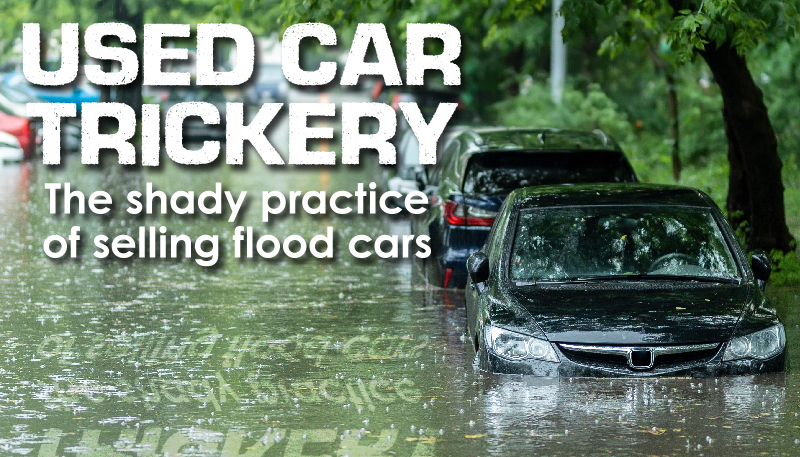
It seems like a couple sizable hurricanes hit the coast each year, wreaking havoc on homes, upsetting people's schedules, and submerging many vehicles in filthy floodwater. Some of those vehicles are demolished legally, but dishonest intermediaries occasionally sell them to willing or unwilling sales outlets, frequently with no knowledge of the vehicle's murky past. Therefore, it's always a good idea to go over the fundamentals of how to avoid purchasing a used car that has flood damage.
First, realize that flood damage cannot be repaired. The modern automobile is a computer system on wheels, loaded with electronics like airbag circuits, engine control units, and seat heaters. Even without considering engine, mechanical, or body problems, that alone can cause considerable damage when a car has been submerged. Not only may windows or radios fail, but airbags might fail to inflate during a collision, endangering your life. And even if a car looks or drives fine right now, rust could cause it to lose those qualities in a year or two.
Second, in the age of Carfax, it's tempting to believe that the used-car market would never accept flood-damaged vehicles. Unfortunately, it isn't always the case. The system's intended operation is as follows: A "salvage" title, or in some states, a "flood" title, is placed on a vehicle after an insurance company determines it to be totaled. It is then sold in bulk, disassembled, salvaged, and repurposed. If it is sold to a buyer, it is done so knowing full well that the title is compromised.
However, things don't always turn out like that. To begin with, there are cars that were never insured in the first place, thus they are never totaled. Second, a branded car can acquire a "rebuilt" title status if someone purchases it at an auction, makes some repairs to it, and then has it reinspected. Consumer Reports claims that in places with lenient laws, it has discovered instances where flooded cars were given a clear title again, a practice known as "title washing."
Buyer beware! Here is some advice from Consumer Reports and others for anyone buying a used car:
1. Is the car from out of state?
Automobiles are frequently relocated from flood zones to places where people are less aware of the problem. Which makes sense, I suppose? You'll have completely forgotten about the hurricanes in a few months. Based in part on the prior registration location of the vehicle, Carfax provides a free flood damage check.
2. Check the history.
Check a vehicle's history with the National Motor Vehicle Title Information System. The National Insurance Crime Bureau's VIN Check program is another option.
3. Get a pre-purchase inspection from a trusted mechanic.
Hire a mechanic to examine the vehicle. The following should be done by the mechanic or you:
4. Use your nose.
Can the car pass a sniff test? Does it have a musty, moldy, or mildewed odor? Does it smell like a deodorant?
5. Check the carpets.
Musty? Stained? Indications of dirt and mud? Worse yet, do they appear to be brand-new replacements? The upholstery is the same. Any water spots? Peel back some carpet in the car and trunk. Any evidence of rust or moisture? Check the spare tire well while you're in the trunk.
6. Look under the seats.
See if the seat mounts and bolts have been wrenched. When a car is being dried out, the seats are often removed. Take a look at the seat's springs (you might need a mirror). Is there rust on the springs?
7. Check under the hood.
Is the crankcase oil reasonably clear or does it look dark? Maybe it's more like the color of chocolate milk? That might indicate water intrusion. Is there a water stain on the paper air filter? On the firewall, inner fenders, or other components, is there any sign of a water line? Is there evidence of silt in the engine compartment's nooks and crannies?
8. Inspect headlights and taillights.
Is there any sign of a previous water line inside? Are they hazy? Water in the lenses isn't always an indication of flooding because housings might leak over time. However, that is still another possible sign of flooding.
9. Check gaps and crevices.
Any location along the back of a body panel, beneath the hood, under the dashboard, in the trunk, or anywhere else. Run your finger over any difficult-to-reach or difficult-to-clean areas. Do you find any mud or silt?
10. Look for rusted fasteners.
Look for rust by checking screw heads and other unpainted metal pieces under the dashboard or in other hidden locations.
11. Get underneath.
See if the rubber drain plugs on the undercarriage look like they've been removed.
12. Take a test drive.
Does it run smoothly? Make sure all of the electronics are functional. Are the stereo speakers clear, or are they garbled or distorted?
For more, check out Consumer Reports' Used Car Buying Guide.